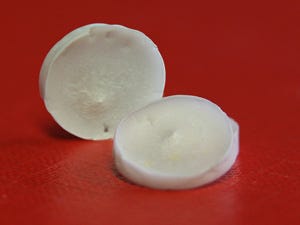Researchers Build Artificial Cardiac Tissue from Silk
February 1, 2012
|
Coin-sized disks cut from the cocoon of the tasar silkworm grub provide a basic scaffold for heart muscle cells. |
Because damaged human-heart muscle cannot be regenerated, scientists from the Max Planck Institute for Heart and Lung Research (Bad Nauheim, Germany) are seeking to restore cardiac function with the help of artificial cardiac tissue. They report that they have succeeded in loading cardiac muscle cells onto a three-dimensional scaffold created using the silk produced by a tropical silkworm. Coin-sized disks cut from the cocoon of the tasar silkworm grub at a university in Kharagpur, India provide a basic foundation for the heart muscle cells.
According to Chinmoy Patra, an Indian scientist who now works in the laboratory of Felix Engel, Research Group Leader at the Max Planck Institute, the fiber produced by the tasar silkworm displays several advantages over other potential scaffold materials: for starters, its surface features protein structures that facilitate the adhesion of heart muscle cells. Secondly, the tasar silk fiber is coarser than other silk fibers. As a result, the muscle cells grow well on tasar silk and can form a three-dimensional tissue structure. "The communication between the cells was intact and they beat synchronously over a period of 20 days, just like real heart muscle," says Engel of his findings.
The reconstruction of a three-dimensional cardiac-tissue structure had posed quite a challenge for scientists. Experiments were performed with many different materials that could provide a scaffold substance for the loading of cardiac muscle cells, but none of those materials---until the discovery of the tasar silk fibers---proved successful.
"Whether natural or artificial in origin, all of the tested fibers had serious disadvantages," says Engel. They were either too brittle, were attacked by the immune system, or did not enable the heart muscle cells to adhere correctly."
Despite the promising results offered up by tasar silk, clinical application of the fiber is not currently planned. "Unlike in our study, which we carried out using rat cells, the problem of obtaining sufficient human cardiac cells as a starting material has not yet been solved," Engel says. It is thought that a patient's own stem cells could be used as starting material to avoid triggering an immune reaction. However, exactly how the conversion of the stem cells into cardiac muscle cells works remains unknown.
About the Author(s)
You May Also Like


.png?width=300&auto=webp&quality=80&disable=upscale)
